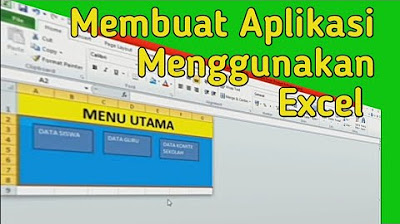Expandable Nested RecyclerView || Android studio Tutorial 2023
Summary
TLDRDans cette vidéo de programmation, l'hôte explique comment créer un RecyclerView imbriqué et extensible. Après avoir amélioré un RecyclerView et un RecyclerView expansible dans des vidéos précédentes, cette vidéo combine ces deux concepts. L'application présentée permet d'agrandir des éléments de RecyclerView pour révéler des sous-éléments, tels que des images et d'autres RecyclerViews. Le tutoriel couvre la création de modèles de données, d'adaptateurs et de la mise en page, ainsi que l'ajout de fonctionnalité d'expansion en cliquant sur des éléments. Le code source est disponible pour aider les téléspectateurs à suivre les étapes.
Takeaways
- 📚 Le tutoriel présente la création d'une vue réutilisable à plusieurs niveaux (nested expandable recycler view).
- 🔗 Il combine les concepts d'une vue réutilisable ordinaire et d'une vue réutilisable étendue (expandable).
- 💻 L'application créée permet l'expansion et la réduction d'éléments dans une liste, comme illustré avec le développement Android.
- 📱 L'interface utilisateur est basée sur des vues de carte (card view) et des vues réutilisables imbriquées pour les sous-éléments.
- 🛠️ Le développement implique la configuration d'un gestionnaire de disposition (layout manager) pour la vue principale et les vues enfants.
- 📝 Deux classes de modèles (data classes) sont créées pour gérer les données des éléments parents et enfants.
- 📑 Les classes d'adaptateurs (adapter classes) sont utilisées pour lier les données aux vues réutilisables correspondantes.
- 🖼️ Des exemples de données, comme les titres et les images, sont incorporés dans les classes de données pour le tutoriel.
- 🔄 La fonctionnalité d'expansion est gérée par un mécanisme qui contrôle la visibilité de la vue enfant en fonction de l'état de l'élément parent.
- 🔄 Lorsqu'un élément est cliqué, la fonctionnalité d'expansion inverse l'état d'expansion et met à jour les autres éléments pour qu'ils soient collapsés.
- 🔗 Le code source complet est fourni dans la description de la vidéo pour permettre aux téléspectateurs de suivre et de mettre en œuvre le tutoriel.
Q & A
Quel est le sujet principal de la vidéo?
-Le sujet principal de la vidéo est la création d'une vue réutilisable imbriquée et extensible dans une application.
Quels sont les deux concepts combinés pour créer cette vue réutilisable?
-Les deux concepts combinés sont la vue réutilisable de base et la vue réutilisable extensible.
Comment appelle-t-on la vue réutilisable dans laquelle on peut cliquer pour l'agrandir?
-Cette vue réutilisable est appelée 'vue parente' ou 'recycler view parent'.
Quel est le rôle du modèle de données 'ChildItem'?
-Le modèle 'ChildItem' est utilisé pour stocker les informations telles que le titre et l'image pour les éléments individuels dans la vue réutilisable enfant.
Quelle est la différence entre 'ParentItem' et 'ChildItem'?
-Le 'ParentItem' contient un titre, une image, une liste d'éléments enfants et un état d'expansion, tandis que le 'ChildItem' contient simplement un titre et une image.
Combien de méthodes doivent être implémentées dans l'adaptateur de la vue réutilisable parente?
-Trois méthodes doivent être implémentées : onCreateViewHolder, onBindViewHolder et getItemCount.
Quel est le but de l'état 'isExpandable' dans le modèle 'ParentItem'?
-L'état 'isExpandable' détermine si l'élément parent peut être agrandi pour révéler les éléments enfants.
Comment la fonctionnalité d'expansion est-elle gérée dans la vidéo?
-La fonctionnalité d'expansion est gérée en inversant la valeur de 'isExpandable' et en modifiant la visibilité de la vue réutilisable enfant.
Quel est le problème rencontré lors du test de l'application et comment est-il résolu?
-Le problème est que plusieurs éléments peuvent être agrandis simultanément. Il est résolu en créant une fonction pour vérifier si un autre élément est agrandi et, si oui, le réduire avant d'agrandir un nouvel élément.
Où peut-on trouver le code source de l'application présentée dans la vidéo?
-Le code source peut être trouvé dans la zone de description de la vidéo.
Outlines

Cette section est réservée aux utilisateurs payants. Améliorez votre compte pour accéder à cette section.
Améliorer maintenantMindmap

Cette section est réservée aux utilisateurs payants. Améliorez votre compte pour accéder à cette section.
Améliorer maintenantKeywords

Cette section est réservée aux utilisateurs payants. Améliorez votre compte pour accéder à cette section.
Améliorer maintenantHighlights

Cette section est réservée aux utilisateurs payants. Améliorez votre compte pour accéder à cette section.
Améliorer maintenantTranscripts

Cette section est réservée aux utilisateurs payants. Améliorez votre compte pour accéder à cette section.
Améliorer maintenantVoir Plus de Vidéos Connexes

Build a Simple Notion Second Brain from Scratch (in ONLY 10 Minutes)

Make Better Beats with this Simple Technique [Beginner Music Production Tutorial]

Apprendre le C# - 17 - Les interfaces (Programmation Orientée Objet)

Amazon KDP low content book publishing || Coloring Book Secrets

Créer un Chat Bot IA gratuit : TUTO character.ai

Notion tutoriel : Organiser ses vidéos Youtube et retenir l'essentiel grâce à Notion ▶️🏷️

Cara Membuat Aplikasi Sederhana Menggunakan VBA Macro Excel
5.0 / 5 (0 votes)